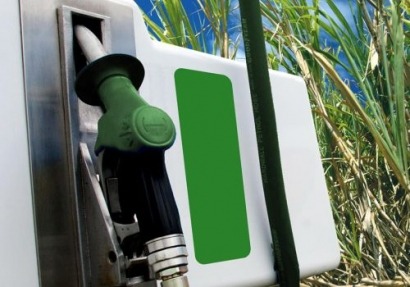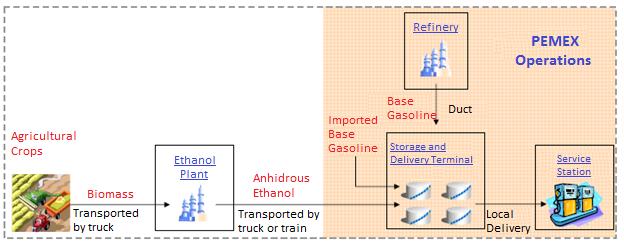
So far, we have reviewed the biofuels industry, specifically focused towards ethanol, and its development in both United States and Brazil, being the leading countries regarding ethanol global production levels and technological innovation applied for this industry. Following this example, many other countries are working towards increased share of renewable sources of energy for their transportation needs currently covered by fossil fuels. From the perspective of Sustainable Development, it is important as well to take into account the importance of social and economic factors regarding how feasible can be the implementation of renewable energy solutions to increase energy security and reduce oil dependence. Thus, no need to further emphasize that the motivations behind this action would include as well jobs creation and greenhouse gases reduction as mentioned by Bloomberg (2012) in their study.
Even though this study was focused specifically in next-generation ethanol development, which includes second and third generation ethanol, the study explores how this kind of productive value chain could contribute to develop a bio-based economy in the next twenty years for eight selected regions, including Mexico. This country, with an economy strongly-dependant to oil resources, is currently facing a clear and present danger represented by a fast falling of their crude production due to aging oilfields and lack of investment, as stated by Hargreaves (2012). Thus, alternative liquid fuels are needed for energy security and to decarbonise the transportation sector. For Mexico the motivations mentioned above hold true, specifically to increase the sense of urgency towards adding some other sources of energy other than fossil fuels.
But how feasible can this be? Before analyzing the current status of ethanol industry in Mexico (although the efforts have been focused in a lower scale towards biodiesel as well), it would be helpful to review the foundations and the studies made so far in this country in order to develop a policy framework to facilitate the implementation. These efforts started as the National Development Plan 2007-2012 identified the implementation of sources of renewable energy as crucial for the country strategic development. Also, an increased use of renewable energy could reduce further damage to natural resources caused by fossil fuel pollution.
The Mexican Ministry of Energy, in their study about the potential and feasibility of usage of bio-ethanol and biodiesel for transportation fuels in Mexico (SENER, 2006), as well as Dominguez-Perez (2008), identified sugarcane ethanol as the most feasible choice, based on studies stating that food resources from agriculture would not be jeopardized. SENER study included other biomass sources for ethanol as corn, yucca, sweet sorghum and sugar beet, for first-generation ethanol production. The selection criteria used for analyzing and choosing the best one for the first stages of ethanol introduction in Mexican gasoline included availability of mature technology, costs, investment requirements, required arable land, energy and greenhouse emissions index.

However, baseline ethanol industry (for purposes other than ethanol fuel) was not sufficiently developed in Mexico, due to several socio-economic factors as obsolete technologies, high production costs, lack of strategic planning, reduced resources as well as a inexistent policy framework. This is summarized by this study as “the issue with production and consumption of ethanol in Mexico could be portrayed as a market failure, resultant of the inadequate calculation of the costs and benefits that the proper development of this industry could bring in several areas for the country”.
To move forward to a further industry development, Dominguez-Perez (2008) identified several factors to influence future biofuels production, as geographical (location and amount of potential cultivated lands, as well as regional climates), agricultural (regional conditions, as soil, seeds, fertility, cultivation and yield), technological (required infrastructure from soil to wheel) and legal (the existence of a policy framework to impulse the production and trade of biofuels). This could be integrated into an energetic reform to face the challenges of the energy sector.
SENER (2006) recommended a gradual ethanol introduction program with three phases. The first phase had an expected timeframe from 2007 to 2012, where produced ethanol would be used to replace methanol used in methyl tert-butyl ether (MTBE) to produce ethyl tert-butyl ether (ETBE). Since 1990, Mexican gasoline uses as oxygenating agent. ETBE is far more convenient than MTBE since the octane level is higher (112 vs 110), as well as having lower vapour pressure, higher boiling point and less solubility (Dominguez-Perez, 2008). By doing this, a 5.7% volume of the gasoline used in the three largest cities in Mexico would be replaced. This was the expectation for 2012, to then increase other biomass sources to increase this percentage to 10% volume of all the gasoline used in the country.
In 2007 the Law for the Promotion and Development of Bioenergetics was approved and finally launched in 2008. Finally the policy framework was established to work as the required foundations to develop further the biofuels industry in Mexico. This law also made provisions on how the Mexican oil company, PEMEX, was expected to release tenders for private companies to start producing ethanol from biomass, preferably sugarcane-based, to achieve the goal by 2012.
However, this was not achieved. Why? As stated by Ganz (2012), there are several factors involved. First one, the instability of the agricultural supply for the potential biomass sources, as sugarcane and corn, where production levels for food are not enough for the country consumption that they need to be imported. Second the prices of ethanol are not stable, since the national market depends on how much the international price fluctuates. This is further discussed by Bosque & Ortigoza (2011) where as discussed previously, high international sugar prices have affected the ethanol production all around the world and in Mexico, so using sugarcane for ethanol fuel is not feasible if sugar would give higher revenue for sugarcane industrials. There are some other factors that could jeopardize the development as expected for Mexican sugarcane ethanol, as stated by Ambriz (cited by Bosque & Ortigoza, 2011) like high water requirements from the production process, less efficiency than corn ethanol and Mexican sugar mills’ obsolete technology.
Next article we will go through the current actions the Mexican Ministry of Energy has been taking to address the obstacles so far found on the road to sustainable biofuels production and use for diversifying the available choices in transportation energy consumption, as well as some other biomass choices rather than sugarcane.
References
Bloomberg New Energy Finance, 2012. Moving towards a next-generation ethanol economy. [Online] 17 February. Available at: http://www.newenergyfinance.com/WhitePapers/view/62 [Accessed 25 August 2012]
Bosque, M. & Ortigoza, N., 2011. Fallan en meta de bioetanol. Reforma. [Internet] 25 Julio. Available at: http://news.atio.com.mx/2011/07/fallan-en-meta-de-bioetanol/ [Accessed 26 August 2012]
Dominguez-Perez, C.A., 2008. Un Análisis Económico Costo-Beneficio del Etanol en México. M.E.A. Tijuana: Colegio de la Frontera Norte. Available at: http://docencia.colef.mx/node/162 [Accessed 26 August 2012]
Ganz, A., 2012. Mexico looks to ethanol production for energy generation. New Energy Connections. [Online] 21 August. Available at: http://www.renewableenergymexico.com/?tag=energia-etanol-mexico [Accessed 26 August 2012]
Hargreaves, S., 2012. Mexico’s big oil problem. CNN Money. [Online] 17 August. Available at: http://money.cnn.com/2012/08/17/news/economy/mexico-oil/index.html [Accessed 25 August 2012]
SENER, 2006. Potenciales y Viabilidad del Uso del Bioetanol y Biodiesel para el Transporte en México. [Online] Secretaría de Energía, Mexico. Available at: http://www.sener.gob.mx/res/169/Biocombustibles_en_Mexixo_Estudio_Completo.pdf [Accessed 25 August 2012]

